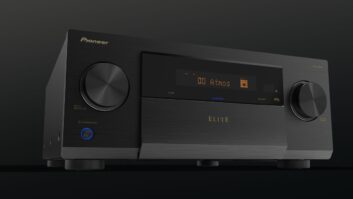
Long Beach, Calif. — Pioneer is bringing down the opening price of multiple technologies in its Elite AV receiver series, including Mobile High-definition Link (MHL), 4K by 2K passthrough, and DTS Neo:X surround.
The changes appear with the launch of two opening-price Elite AVRs, the $525-suggested 7.1-channel VSX-43 and the $750 7.2-channel VSX-70. They replace the $500-suggested 7.1-channel VSX-42 and $700-suggested 7.2-channel VSX-60.
With the launch, Elite AVRs for the first time get 4K by 2K up-scaling, which appears in the $750 model.
Like the models they replace, both new models are equipped with such networking capabilities as Apple AirPlay, DLNA 1.5, Windows 7 compatibility and vTuner Internet radio. The $750 model adds Pandora, which appeared along with the Rhapsody and SiriusXM streaming in the AVR’s predecessor.
Both new models also feature HTC Connect, which was added as a firmware upgrade last year to 2012 AVRs models to simplify and improve the performance Wi-Fi streaming from an HTC smartphone. Both models can also be controlled from an iOS or Android mobile device loaded with Pioneer’s Control App. And both models, like their predecessors, feature Dolby Pro Logic IIz post processing to generate two front-height channels.
In this year’s models, MHL and 4K by 2K passthrough migrate down to $525 from $1,600. The MHL 2.0 input enables MHL-equipped mobile devices to send 1080p video and 7.1-channel audio over a cable to the receiver. The connection also charges the mobile device and enables navigation of the smartphone’s UI via the AVR’s remote. MHL 2.0 supports 3D content and faster smartphone charging.
For the first time in the Elite series, 4K by 2K up-scaling puts in an appearance, starting with the $750 AVR, which up-scales from HDMI-, component- and composite-video sources, the company’s website shows.
The $750 AVR also marks a new opening price for DTS Neo:X surround in the Elite series, which previously started the technology at $1,600. Neo:X up-mixes stereo and multichannel audio programs to as many as 11.1 channels in the AVRs starting at $1,600, but the $750 AVR delivers up to 7.1 channels. Neo:X can add a pair of front-height and front-wide channels to a sound system.
In other changes, the $525 AVR adds two-source, two-zone capability compared to the predecessor’s speaker A/B capability, and the $750 model adds three-zone capability with HDMI over the third zone. Its predecessor had two-zone audio capability.
Like their predecessors, both new models feature Made For iPod/iPhone/iPad front-panel USB, port for an optional $99 Bluetooth adapter, Sound Retriever Air to improve Bluetooth-sound quality, remote control from iOS and Android devices, and USB and network playback of music files in multiple formats, including AIFF, Apple lossless, WAV, FLAC, MP3, WMA and AAC. The step-up model adds DSD playback over USB and a home network.
Other features on the $525 VSX-43 include 192kHz/24-bit playback of AIFF, WAV and FLAC files, HDMI standby passthrough, MCACC room correction, two-channel Advanced Sound Retriever to improve the sound quality of compressed audio, front bi-amp mode, six HDMI 1.4a inputs, one HDMI 1.4a output with audio return channel, and SACD to PCM conversion. It’s rated at 7×80 watts from 20Hz to 20kHz with 0.08 percent THD into 8-ohm loads.
The $750 VSX-70 adds multiple features, including a second subwoofer output, multichannel SACD decoding, 7×90-watt amplification, eight HDMI 1.4a inputs, two HDMI outputs (one for the second zone), 4K by 2K upscaling, integration with home-control systems, optional Wi-Fi dongle, composite- and component-video conversion to HDMI, advanced MCACC room correction, more advanced control from Pioneer’s Android and iOS app, and listening modes that simulate virtual-wide, virtual-depth, virtual-height and virtual surrounds-back speakers.
The step-up model also features Stream Smoother, which improves the picture quality of compressed video streamed from the Internet through such sources as connected Blu-ray players.













